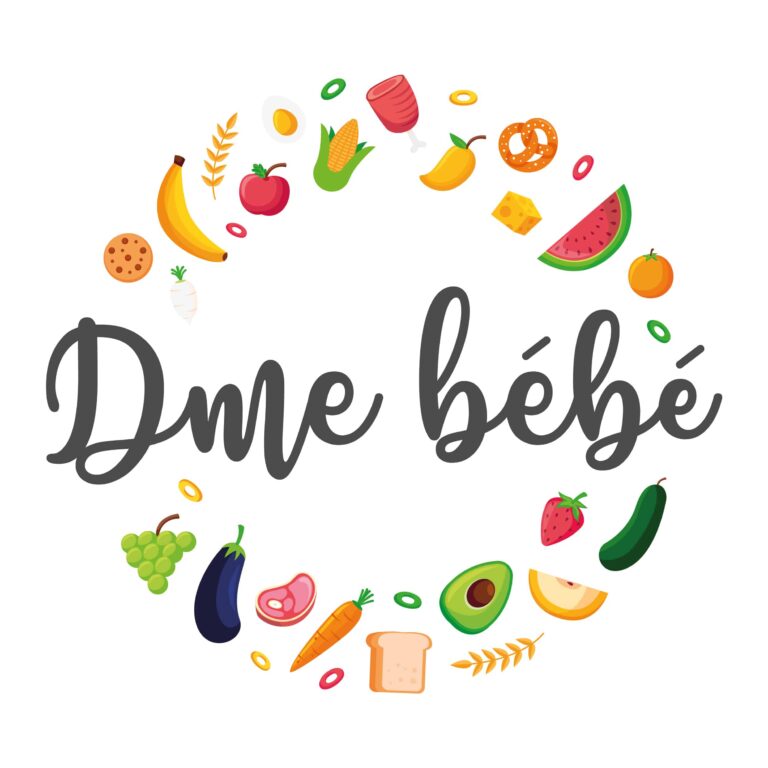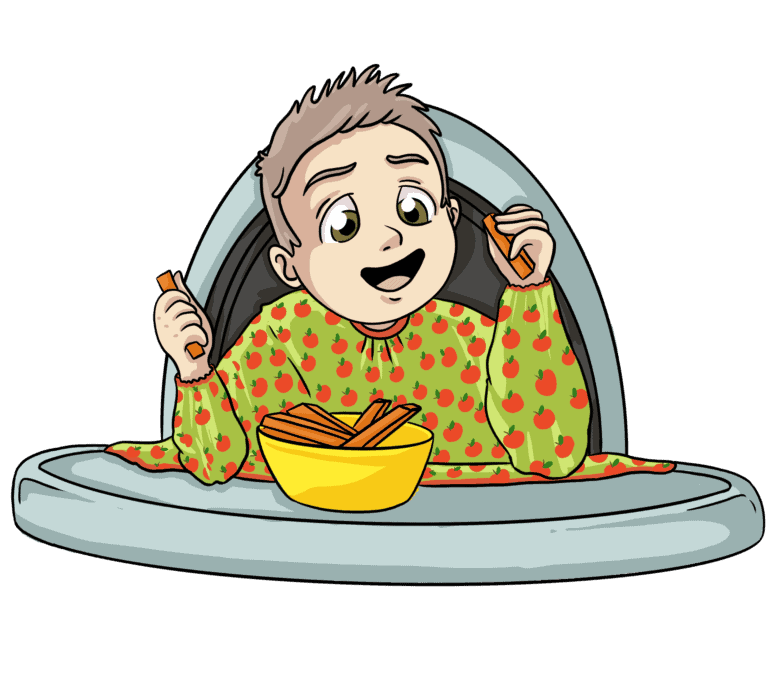There are currently 14 major allergens . These must appear in bold in the list of ingredients for industrial products. So be sure to check the presence of these allergens on the labels :
- Gluten (wheat, rye, barley, oats, spelled),
- crustaceans,
- eggs,
- peanuts,
- fish,
- soybeans,
- Milk,
- hull fruits (almonds, hazelnuts, etc.),
- celery,
- mustard,
- sesame,
- sulfites*,
- The Lupine **,
- Molluscs.
On each of our recipes, allergens are indicated before the complete recipe with its ingredients and instructions.
*Sulfites are naturally present in certain foods. They are also used as food additives.
** The Lupine is a legume.
When should we introduce allergens into baby's diet?
It is strongly advised to introduce allergens into baby's diet from the start of BLW , regardless of the family allergic history . Indeed, recent studies have proven that early exposure (before one year of baby) to allergens can reduce the risk of developing food allergies .
How to introduce allergens?
One at a time and three days in a row.
Allergens should be introduced one by one . This allows, in the event of an allergic reaction, to know the responsible food. Also, be sure to respect the 3 -day rule : offer three days in a rippers. Indeed, it will take at least two exhibitions to an allergen before the antibodies can create a reaction (if it takes place). If, at the end of the three days, no reaction has occurred, you can include this food in the general baby food and test the continuation of another allergen.
Photo: © Moon and the other

In what amount to introduce allergens?
Offer very small amounts of an allergen to start. The goal is that baby is in contact with the allergen potential.
You can present to baby the food alone, an omelet strap for example, or even mix it with another food (which is not an allergen itself), like peanut butter mixed with compote, for example.
How to recognize an allergic reaction?
In general, an allergic reaction occurs 30 minutes after ingestion of a food, but it can also occur a few hours or a few days later . So be vigilant.
Here are some signs that reflect an allergic reaction:
- Vomiting, diarrhea
- Sudden behavior change
- Red plates, hives, eczema
- Asthma
- Throat or lips that swell (difficulty breathing)
At the slightest doubt, contact your doctor!

Zoom on some allergies and intolerances
Gluten
Gluten allergy
Gluten allergy is an immune reaction that occurs when the body reacts to gluten proteins, present in certain grains such as wheat, rye and barley. This can cause several symptoms:
- Digestive (abdominal pain, diarrhea, bloating)
- Skin (rashes, itching)
- Neurological (fatigue, concentration disorders)
Gluten alternatives for allergic children
Opt for gluten -free certified cereals (rice, quinoa, millet, buckwheat or oat) and look for gluten -free breads and pasta (which are now widely available in stores and bakeries).
Promote fruits and vegetables because they are naturally gluten -free and constitute a healthy base for baby's diet. Note that legumes (beans, lenses and chickpeas) are excellent sources of protein and are gluten -free.
Dairy products such as yogurt and cheese are generally gluten -free and can be included in baby's diet, unless it is also allergic to milk, of course.

Gluten intolerance
Gluten intolerance does not cause an immune reaction, but can also cause digestive symptoms. The body is struggling to digest gluten and this can cause:
- Bloating
- Abdominal pain
- Diarrhea
- Headache
These symptoms generally occur several hours after consumption of gluten.
How do you know if baby has gluten intolerance?
There is no specific test to diagnose gluten intolerance. The diagnosis is often made by exclusion, first eliminating other conditions, such as celiac disease, and observing the improvement of symptoms after the elimination of food gluten.
The egg
Egg allergy occurs when the immune system identifies the proteins present in egg whites (and sometimes in yolks) as a threat. This can cause various symptoms ranging from skin irritation to more serious reactions, such as breathing difficulties or anaphylaxies in certain cases.
If baby is allergic to eggs, read the labels carefully, because the eggs can hide in many products, including pastries, sauces, and even certain prepared dishes. Avoid whole eggs, but also egg products such as omelets, soufflés and meringues.

Egg alternatives for allergic children
There are several alternatives to eggs that can be used in recipes and meals to ensure adequate nutrition.
The liquid present in the cans of chickpeas, called aquafaba , can replace the egg in recipes that require egg whites mounted in snow , such as meringues or homemade mayonnaise. 3 tablespoons of Aquafaba replace 1 whole egg and 2 tablespoons of Aquafaba replace 1 egg white.
To replace beaten eggs often used in bakery recipes, you can use a mixture of water and flax flour . You will get the desired consistency. To replace 1 egg, mix 1 tablespoon (15ml) of 2 tablespoons (30 ml) of water and let swell for 5 minutes. This tip only works for recipes that contain 1 or 2 eggs, or even 3 maximum.
Used as egg substitute in cake recipes, apple compote helps to link the ingredients while adding natural sweetness. For 1 egg, use a cup of apple compote. This alternative mainly gives a good result in the muffins .
Banana puree is another sweet alternative that can replace eggs in certain preparations. For 1 egg, use a banana.
In the form of tofu or yogurt, soybeans is an ingredient that allows eggs to be replaced in recipes that require large quantities . For omelettes or mascarpone, the firm tofu is a good substitute (with a pinch of turmeric for color). The silky tofu is suitable in the recipes that need a rising agent (soufflés) or a strong bond power (mayonnaise, gratins, quiches, etc.). Finally, soy yogurt will replace eggs in recipes that require a rising agent containing a lot of humidity. Count 50 g of tofu to replace 1 egg. Be careful however, soybeans is also an allergen.
Soybeans
Soy allergy is an allergic reaction that occurs when the immune system identifies certain proteins present in soybeans as harmful substances. This can cause various symptoms ranging from skin irritation to more serious reactions, such as breathing difficulties or anaphylaxies in certain cases.
If baby is allergic to soy, read the labels carefully, because soybeans are hidden in many products, including sauces, prepared dishes and meat substitutes. Ingredients like soy lecithin and tofu must also be avoided, like all soy products, until a clear diagnosis has been established.
With its strong composition in phyto-esrogens, possible endocrine disruptors, it is best to avoid soybeans until the age of 3 years.
Soy alternatives for allergic children
Soy has many nutritional assets. It is important in a more vegetable diet, less rich in meat. Other legumes such as lenses , chickpeas , and beans are excellent alternatives, rich in protein and fiber.
If baby does not have milk allergy, dairy products such as yogurt and cheese can be integrated into its diet. Quinoa and other cereals can also provide essential proteins and nutrients .
Finally, lean meats such as chicken, turkey or beef offer essential proteins.
Milk
Allergy to cow's milk or APLV (allergy to the cow's milk protein)
Milk allergy and cow's milk protein allergy are actually the same. When we talk about cow's milk allergy, it is always a reaction from the immune system to proteins contained in cow's milk (such as casein and whey).
Cow's milk allergy is one of the most frequent food allergic in infants and young children. Symptoms may include:
- Digestive disorders (vomiting, diarrhea)
- Rashes (hives, eczema)
- Breathing difficulties (asthma, whistling breathing)
- (asthma, whistling breathing)
- Anaphylactic shock (in serious cases)
Milk allergy should not be confused with lactose intolerance, which is an inability to digest lactose (milk sugar) and which is mainly manifested by digestive symptoms, without involvement of the immune system.
Alternatives to cow's milk protein for allergic children
If a cow's milk protein allergy is confirmed, several alternatives exist to ensure a balanced baby diet.
Vegetable milks ( oat milk, rice milk, etc.) enriched with calcium can replace cow's milk. Watch out for almond and soy milks that each contain one of the 14 major allergens! Also pay attention to lactose -free dairy products which are only suitable in the event of lactose intolerance, but still contain milk proteins.
Goat or sheep milk , as well as goat or sheep cheeses are generally not recommended for APLV babies. Although these milks can contain proteins different from those of cow's milk, they often contain similar proteins, such as casein, and other potential allergens that can trigger allergic reactions in some people. However, sensitivity is individual. Some people allergic to cow's milk can tolerate goat or sheep milk, while others will develop allergic symptoms. It is therefore important to carry out tolerance tests under medical supervision.

Lactose intolerance
Lactose intolerance concerns a digestion problem. It occurs when the body does not produce enough lactase, the enzyme responsible for the decomposition of lactose (natural sugar of milk).
This can cause digestive symptoms such as:
- Abdominal bloating and discomfort
- Gases and pain after the consumption of dairy products
- Diarrhea in the event of accumulation of non -digested lactose.
Unlike allergy, lactose intolerance does not generally put life in danger and does not cause immune reactions. It is however advisable to limit lactose in its diet for more comfort.
The difference between allergy and lactose intolerance
It is common to confuse allergy to cow's milk proteins (APLV) with lactose intolerance, simply because they both involve cow's milk. However, responsible substances are different. Allergy concerns milk proteins , while intolerance affects lactose . It is therefore important not to say that we are "allergic to lactose", because allergy is always linked to proteins.
Coque fruits
The allergy to hull fruit is relatively common , especially in children, but it can persist in adulthood.
The shell fruits include, among other things, almond, Grenoble nuts, pecan, hazelnut, macadamia nuts, cashews, pistachio, etc.
Symptoms of an allergic to shell fruit may include:
- Skin reactions (rashes, itching or hives)
- Gastrointestinal symptoms (abdominal pain, nausea, vomiting, diarrhea)
- Anaphylactic reactions (in serious cases).
If baby is allergic to shell fruit, the best is to completely avoid these foods . Inform those around you to prevent any accidental exposure and be vigilant by reading food labels, because shell fruits can be present in unexpected products. Indeed, many energy bars, such as granolas, contain nuts. But that's not all! Cookies, cakes and breads can be prepared with nuts and certain sauces and marinades can include nuts as the main ingredient.
Sulfites
Sulfites are chemical compounds used as preservatives to prevent oxidation and prolong the storage time of food products.
Although most people tolerate sulfites without problem, some people can develop symptoms ranging from light to severe, such as:
- Skin eruptions
- Headache
- Nausea
- Breathing difficulties or anaphylactic reactions (in extreme cases)
In what food do we find sulfites?
It is important, when baby has never been in contact with sulfites, to take the time to read the labels . This will allow you to know if the food or the processed product contains sulfites and to avoid it in the event of an allergy.
They are present in a variety of foods and drinks, in particular:
- Dry fruits : dried apricots, raisins, and other dried fruits can contain sulfites to maintain their color and freshness.
- Potato products : frozen fries or instant puree can be treated with sulfites.
- Bakery products : Some breads and pastries may contain sulfites as conservation agents.
- Condiments and sauces : sauces, marinades and certain condiments can also contain sulfites .
- Preserved vegetables : especially those that are bleached or preserved in sulfite solutions.
- Some spices such as garlic powder
And even if it does not concern baby, it is important to also know that sulfites are present in wines and spirits in order to stabilize wine and prevent oxidation. This is particularly true for white wines and certain red wines.
Alternatives to sulfites for allergic children
Opt for fresh fruits and vegetables rather than dried fruits or canned vegetables. Also limit processed products and reduce the consumption of processed potatoes, commercial sauces and pastries.


2 responses